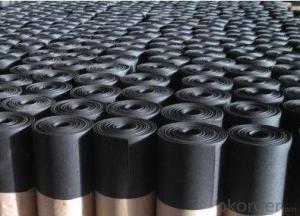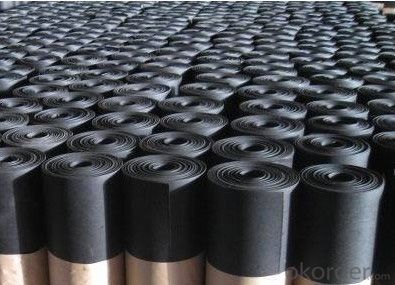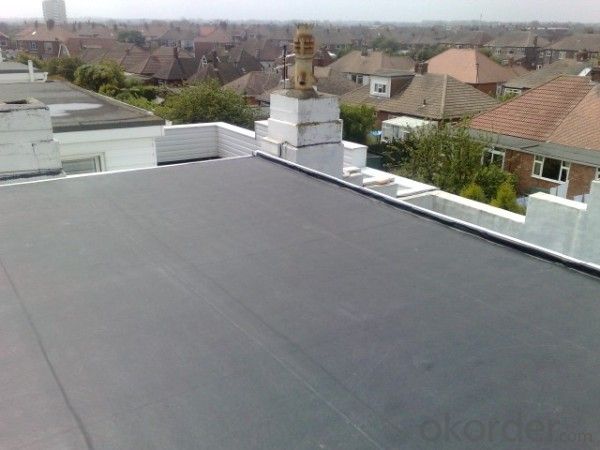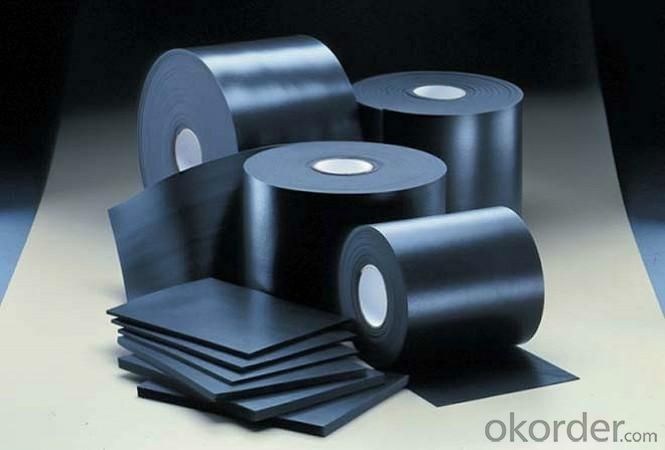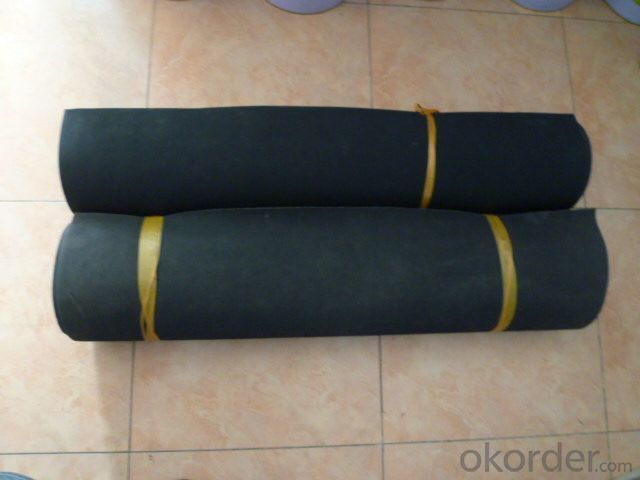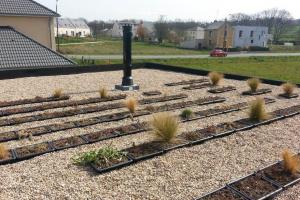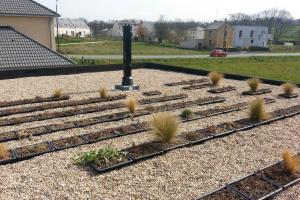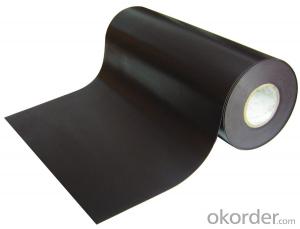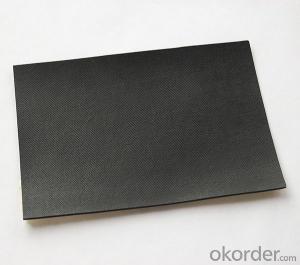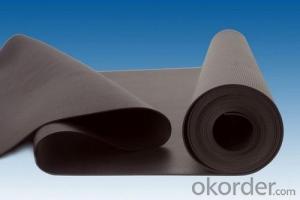EPDM Waterproofing Membrane for Agriculture
- Loading Port:
- Shanghai
- Payment Terms:
- TT OR LC
- Min Order Qty:
- 50000 m²
- Supply Capability:
- 5000000 m²/month
OKorder Service Pledge
OKorder Financial Service
You Might Also Like
EPDM Waterproofing Membrane for Agriculture
Description Of EPDM Waterproofing Membrane for Agriculture:
·Filament polyester filler base sheet material:
·The combination of filament polyester filler base and SBS modified bitumen forms an excellent comprehensive performance and high quality waterproof sheet material;
·High strength waterproof layer and strong water pressure resistance;
·Good performance of breaking resistance, tearing resistance, fatigue resistance, corrosion resistance, mould resistance and weather resistance;
·High tensile strength, high elongation, high adaptive capacity to base shrinkage deformation and fracture;
·Good resistance performance of low and high temperature: It could still work under -20℃ , be applicable to cold and hot regions, especially in chilly region;
·Good workability: It can be constructed by heat fusion method in the four seasons of the whole year and hot-joint is reliable and durable.
·Alkali-free glass fiber filler base sheet material:
·Combination of economical filler base and high performance SBS modified bitumen.
·Higher tensile strength, excellent resistance to high and low temperature.
·Good performance of corrosion resistance, mould resistance, weather resistance and good workability.
·Glass fiber reinforced polyester filler base sheet material:
·It is safe and eco-friendly by using mechanical mounting of construction.
·The product has better dimensional stabiliy.
Main Features of EPDM Waterproofing Membrane for Agriculture:
·Polyester felt filler base elastic modified bituminous waterproof sheet material is appropriate for the roof and underground waterproof constructions of industrial and civil engineering projects;
·Waterproof type Ⅱ is appropriate for roof type Ⅰ , Ⅱ and underground waterproof projects;
·Glass fiber reinforced polyester filler base sheet material is appropriate for mechanical mounting single layer waterproofing, but must pass the wind load test;
·Glass fiber felt filler base sheet material is appropriate for the roof of structural stable buildings and underground waterproof projects;
·Exposed surface is suitable to have waterproof sheet material with non-transparent mineral particle as upper surface isolating material;
·The waterproof sheet material with find sand as surface isolating material is appropriate for underground construction projects.
Specifications of EPDM Waterproofing Membrane for Agriculture:
| Number | Item | Unit | Value | |
| 1 | Size Variation | Thichness | % | ±10 |
| Width | % | ±1 | ||
| Length | % | Allowed negative | ||
| 2 | Breaking tensile strength at normal temperature | Mpa | ≥7.5 | |
| Breaking tensile strength at 70°C | Mpa | ≥2.3 | ||
| 3 | Breaking elongation at normal temperature | % | ≥450 | |
| Breaking elongation at -20°C | % | ≥200 | ||
| 4 | Tear strength | KN/m | ≥25 | |
| 5 | Impermeability(30min) | * | 0.3Mpa no leakage | |
| 6 | Bending at low tempreture | °C | ≤-40 | |
| 7 | Stretch tensor at heating | Elongate | mm | ≤2 |
| Shrink | mm | ≤4 | ||
| 8 | Air oven aging(80°C×168h) | Tensile strength at break retained | % | ≥80 |
| Elongation at break retained | % | ≥70 | ||
| 9 | Anti-alkali | Tensile strength at break retained | % | ≥80 |
| Elongation at break retained | % | ≥80 | ||
| 10 | Nuture weathing at manual simulation | Tensile strength at break retained | % | ≥80 |
| Elongation at break retained | % | ≥70 | ||
Applications of EPDM Waterproofing Membrane for Agriculture:
Widely used in roofs, basement, toilet ,swimming pool, and all kinds of industry and civil building waterproofing, reservoir, vivicism, bridge, underground, tunnel and dam waterproofing ,especially to the keystone waterproofing projects which is durability, high corrosion resistance and easy deformation.



IMages of EPDM Waterproofing Membrane for Agriculture:




FAQ of EPDM Waterproofing Membrane for Agriculture:
1. What are we supplying?
We are specialized in producing Colorful Asphalt Roof Shingle, SBS/APP modified bitumen waterproof membrane, Self adhesive bitumen waterproof membrane, PVC waterproofing membrane, EPDM rubber roofing membrane, Single Component Polyurethane Waterproof Coating, and Spray Polyurea Waterproof Coating
.
2. How Many years experience do we have?
We have been exported to more than 20 countries in the past 15 years.
3. How long do we usually reply your request?
We always reply our customer within 24 hours.
- Q: Can a waterproofing membrane be used on roofs with skylights?
- Certainly, roofs with skylights can benefit from the use of a waterproofing membrane. It is strongly advised to employ a waterproofing membrane around skylights in order to prevent water infiltration or leakage. Skylights have the potential to become weak points in a roof system, as they form openings that can let water seep through if not adequately sealed. The application of a waterproofing membrane around the skylights serves to establish a watertight barrier that safeguards the roof from any potential leaks. Furthermore, a waterproofing membrane also offers added protection against external factors such as UV rays and changes in temperature, thereby extending the lifespan of both the skylights and the roof itself.
- Q: Can a waterproofing membrane be used on bridges?
- Yes, a waterproofing membrane can be used on bridges. It is a common practice to use waterproofing membranes on bridge decks to protect them from water infiltration, which can cause damage and deterioration over time. The membrane acts as a barrier, preventing water from penetrating the bridge deck and protecting the underlying structure.
- Q: How does a waterproofing membrane handle exposure to UV rays and sunlight?
- Various mechanisms are employed in the design of a waterproofing membrane to withstand exposure to UV rays and sunlight. Firstly, UV stabilizers and additives are incorporated into most waterproofing membranes to shield the material from the harmful effects of prolonged UV radiation. These stabilizers effectively prevent the membrane from deteriorating and breaking down when exposed to sunlight. In addition, many waterproofing membranes are manufactured with reflective pigments or coatings that assist in reflecting a significant portion of the sun's rays. This reflective quality reduces the absorption of UV radiation, minimizing heat absorption by the membrane. Consequently, the membrane remains cooler, bolstering its durability and extending its lifespan. Furthermore, certain waterproofing membranes are reinforced with materials like fiberglass or polyester to provide extra strength and resistance against UV rays. These reinforcing materials act as a barrier, safeguarding the membrane from direct exposure to sunlight and diminishing the risk of sun damage. It should be noted that although waterproofing membranes are designed to withstand UV exposure, their performance can be influenced by factors such as the intensity and duration of sunlight exposure, climate conditions, and maintenance practices. Regular inspections and maintenance, including the application of UV protective coatings or sealants, can aid in prolonging the life and effectiveness of the waterproofing membrane in areas with high UV exposure. Ultimately, a well-designed and correctly installed waterproofing membrane is engineered to endure UV rays and sunlight, ensuring long-term protection and durability for the underlying structure.
- Q: Are there any specific requirements for installing a waterproofing membrane?
- Yes, there are specific requirements for installing a waterproofing membrane. Some key requirements include ensuring a clean and dry surface, proper preparation of the substrate, correct application of the membrane according to manufacturer's instructions, and adequate curing time. Additionally, ensuring proper seam and joint treatments, as well as sufficient overlap and termination details, are essential for an effective waterproofing installation. It is crucial to follow the specific guidelines and recommendations provided by the manufacturer to ensure a successful and long-lasting waterproofing system.
- Q: Can a waterproofing membrane be used on metal block surfaces?
- Metal block surfaces can indeed benefit from the use of a waterproofing membrane. These membranes are specifically designed to form a barrier against water and moisture, and they are versatile enough to be applied to various types of surfaces, including metal. By adhering to the metal surface, the membrane creates a protective layer that not only prevents water infiltration but also safeguards the metal against rust and corrosion. However, it is crucial to guarantee that the metal surface is thoroughly cleaned, dried, and appropriately prepared before the application of the waterproofing membrane. This preparation ensures optimal adhesion and effectiveness. For specific instructions on using a waterproofing membrane on metal block surfaces, it is highly recommended to consult a professional or refer to the manufacturer's guidelines.
- Q: Does a waterproofing membrane require any maintenance or regular inspections?
- Yes, a waterproofing membrane does require regular maintenance and inspections. Over time, the membrane can become damaged or deteriorate, leading to leaks or other issues. Regular inspections help identify any potential problems early on and allow for timely repairs or replacements. Additionally, periodic maintenance such as cleaning and resealing may be necessary to ensure the membrane's effectiveness and longevity.
- Q: Can a waterproofing membrane be used for a balcony deck?
- Yes, a waterproofing membrane can be used for a balcony deck. Waterproofing membranes are specially designed to create a barrier against water penetration, which is essential for protecting structures such as balcony decks from moisture damage.
- Q: Can a waterproofing membrane be used for bridges or parking decks?
- Yes, a waterproofing membrane can be used for bridges or parking decks. Waterproofing membranes are specifically designed to protect structures from water damage and are commonly used in construction projects for this purpose. Bridges and parking decks are exposed to various weather conditions, including rain, snow, and ice, which can lead to the deterioration of the concrete and steel components. By applying a waterproofing membrane, the structure is protected from the ingress of moisture, preventing corrosion, cracking, and other forms of deterioration. Additionally, waterproofing membranes can also provide additional benefits such as improved durability, increased lifespan, and reduced maintenance costs for these structures. Therefore, using a waterproofing membrane is a recommended solution to ensure the long-term integrity and functionality of bridges and parking decks.
- Q: Can a waterproofing membrane be used for a water tank sealant?
- Yes, a waterproofing membrane can be used as a water tank sealant. Waterproofing membranes are designed to create a barrier against water penetration, making them an effective choice for sealing water tanks and preventing leaks.
- Q: Does a waterproofing membrane provide any soundproofing benefits?
- A waterproofing membrane, unfortunately, does not offer any advantages in terms of soundproofing. Its sole purpose is to safeguard surfaces against water infiltration, such as roofs, walls, or foundations. It is typically composed of materials like asphalt, rubber, or polyethylene, which are not effective in obstructing or absorbing sound waves. On the other hand, soundproofing entails the utilization of distinctive materials and techniques that can diminish or eradicate the transmission of sound from one area to another. This may involve insulation, acoustic panels, or soundproof barriers. Consequently, if soundproofing is a concern, it is essential to contemplate separate soundproofing measures in conjunction with a waterproofing membrane.
Send your message to us
EPDM Waterproofing Membrane for Agriculture
- Loading Port:
- Shanghai
- Payment Terms:
- TT OR LC
- Min Order Qty:
- 50000 m²
- Supply Capability:
- 5000000 m²/month
OKorder Service Pledge
OKorder Financial Service
Similar products
Hot products
Hot Searches
Related keywords
